2 II C. Understanding Creative Commons Licenses
Unlocking the secrets of open and creative commons licensing
Creative Commons Licenses
Creative Commons (CC) is an international non-profit organization providing standardized licenses under copyright law, to help copyright owners efficiently communicate precisely how they intend to make their work available for public use. CC Licenses provide consistent and easy to interpret licenses, using abbreviations and graphic symbols to:
- simplify the process of making copyrightable works available for public use;
- identify which rights the owner intends to share; and
- stipulate any conditions the owner puts upon future uses.
All CC licenses except the Public Domain (Ø) designation requires attribution of the creator or owner of the work. Other restrictions limit use, are optional and may prevent reuse in unintended ways. Care is recommended in selecting license terms.
Licenses give blanket permission for named groups to use copyrightable works in limited ways, preserving all or some of the owner’s rights under copyright law. Licensing is the act of applying license terms to a work, and has legal consequences.
Conditions for licensing include:
- only copyrightable work may be licensed;
- works may be licensed by legitimate rights holders only; and
- once placed in the public domain, works cannot be removed and become ineligible for further claims of copyright.
Open and Creative Commons Licenses are irrevocable.
Copyright owners (rights holders) who wish to make their copyrightable work available for public use may indicate the rights of attribution, reuse, and modification they intend to share by selecting from among the restrictions listed below and either apply a Creative Commons (CC) License or provide license terms in written form, spelling out each of the rights and stipulations. Regardless of how the terms appear, read and follow the license provided. Avoid works without visible license information attached to the work.
This video gives an overview of the process.
License Terms Explained
The rights which the owner may transmit to the public include the rights of:
- attribution (if you must identify the creator);
- copying and distribution (if you can share and how);
- the right to make derivative works (if you may adapt and change); and
- the right to remuneration for use (if user may earn money).
Creative commons licenses and any protections they afford do not exceed those of copyright law.
Attribution (BY) 
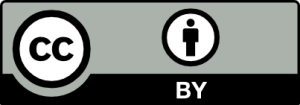
Enables reusers to distribute, remix, adapt, and build upon the material in any medium or format, in any reasonable manner, but not in any way that suggests the author or owner endorses you or your use. Provide a link to the source. All CC licenses except CCØ require attribution. Appropriate formatting for attribution is discussed in the last section of this chapter.
CC BY includes the following elements:
BY: credit must be given to the creator.
You can combine a BY source with…. Share Alike, Non-Commercial, CCØ, and Public Domain.
![]()
![]()
![]()
![]()
Share Alike (SA) 
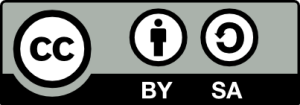
Enables reusers to distribute, remix, adapt, and build upon the material in any medium or format, so long as attribution is given to the creator. , but you may only distribute derivative works under the same license as the original.
CC BY-SA includes the following elements:
![]() BY: credit must be given to the creator.
BY: credit must be given to the creator.
![]() SA: Adaptations must be shared under the same terms.
SA: Adaptations must be shared under the same terms.
If you are combining sources, you can combine an SA source with…CCØ, Public Domain, Attribution By, and Non-Commercial.
![]()
![]()
![]()
![]()
Non-commercial (NC) 
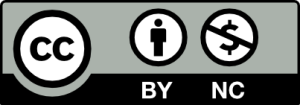
Enables reusers to distribute, remix, adapt, and build upon the material in any medium or format for noncommercial purposes only, and only so long as attribution is given to the creator.
CC BY-NC includes the following elements:
![]() BY: credit must be given to the creator.
BY: credit must be given to the creator.
![]() NC: Only noncommercial uses of the work are permitted.
NC: Only noncommercial uses of the work are permitted.
If you are combining sources, you can combine an NC source with CCØ, Public Domain, Attribution By, and Share Alike
![]()
![]()
![]()
![]()
![]()
No Derivative Works (ND) 
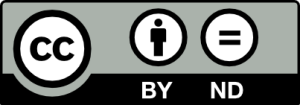
Enables reusers to copy and distribute the material in any medium or format in unadapted form only, and only so long as attribution is given to the creator.
CC BY-ND includes the following elements:
![]() BY: credit must be given to the creator.
BY: credit must be given to the creator.
![]() ND: No derivatives or adaptations of the work are permitted.
ND: No derivatives or adaptations of the work are permitted.
A second version of this license, CC BY NC ND enables reusers to copy and distribute the material in any medium or format in unadapted form only, for noncommercial purposes only, and only so long as attribution is given to the creator.
CC BY-NC-ND includes the following elements:
![]() BY: credit must be given to the creator.
BY: credit must be given to the creator.
![]() NC: Only noncommercial uses of the work are permitted.
NC: Only noncommercial uses of the work are permitted.
![]() ND: No derivatives or adaptations of the work are permitted.
ND: No derivatives or adaptations of the work are permitted.
If you are combining sources, you can combine an ND source with CCØ, Public Domain, Attribution By, Share Alike and Non-Commercial
![]()
![]()
![]()
![]()
![]()
![]()
Creative Commons Public Domain Dedication, (CCØ,)  ,
,
Allows owners to waive all copyrights, meaning that you may use or combine this source in any manner, with no conditions.
Out of Copyright Public Domain 
Used for work having “fallen out” of copyright protection to mark a work as having “fallen into” the public domain.
You may use or combine this source in any manner, with no conditions.
The following graphics visually represent the information above. The first shows the creative commons license from most free to least free.
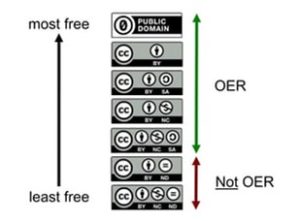
The second shows which licenses may be combined.
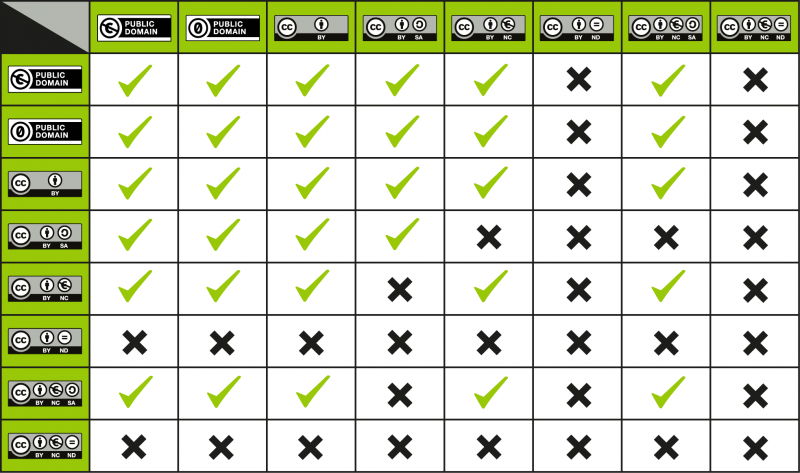
This is a license compatibility chart when you want to combine or mix two CC licensed works.
To learn more about the designs, rationale, and structure of Creative Commons licenses, read about the licenses.
A Process for Applying and Combining Licenses
Appropriate attribution is a necessity in education, and there is a standard practice in OER for any type of attribution
The acronym TASL represents the creative commons norms for attributing materials.
Title – if a title is included in the original work, it must be included in attribution
Author – the word fits the acronym, but actually represents the owner of the content
Source – include a URL or hyperlink where the work resides. It is also better to use the original URL instead of a shortened link, whether you are hyperlinking or printing out the entire URL.
License – specify which CC license was applied to the work you are reusing. Each of the six different CC licenses come with distinct requirements for re-use.
We recommend that you name and provide a link to the license, e.g., CC BY 4.0 (http://creativecommons.org/licenses/by/4.0) for a work licensed under CC BY 4.0.
Although different disciplines require different formatting, here’s what we recommend for consistency withing the NMOER Consortium.
- All sources should be collected at the bottom of page / end of chapter
- Graphics, audio, video, and other media should have an additional attribution within the text.
Additional questions about licensing? This CCWiki addresses considerations before licensing.
If you are unsure how to attribute works you have used, try this attribution builder: http://www.openwa.org/open-attrib-builder/
Questions for next steps
License and Attribution
Creative Commons Graphics, Adapted from https://creativecommons.org/licenses Licensed under a Creative Commons Attribution 4.0 License. Icons by the Noun Project
Creative Commons text adapted from https://creativecommons.org/share-your-work/cclicenses/ . Licensed under a Creative Commons Attribution 4.0 License.
Scale of Creative Commons Licenses from most free to least free. From Updated Keynote Slides; Cable Green; slideshare; CCBY
License Compatibility Chart Created by Kennisland published under a CC0 license.
TASL adapted from Recommended Practices for Attribution Creative Commons Attribution 4.0 license.
